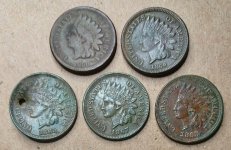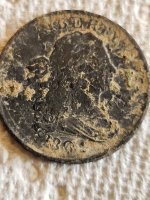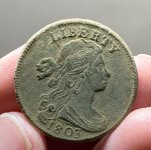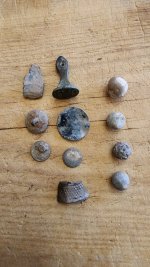goldenrecoveries
Full Member
While Sherman's army was making it's march through South Carolina, the citizen's in the Lancaster county area took
all their valuables to the Bank Of Camden. This included gold, paper money, jewelry, and even a very heavy solid
gold pitcher that had been gifted to a mister John C. Calhoun by the Ladies of Charleston. The total value of
the cash and valuables was $163,000. (1860's value)
The bank officials then gathered it all up, and headed for Hanging Rock with a plan to bury it all so it would be safe from the
advancing Union army.
While in route to Hanging Rock they ran into a small detachment of Union soldiers. Of course the soldiers confiscated
everything, and for whatever reason, the soldiers decided to bury it all, and for some reason they selected a man from their
outfit named Rhodes, and only him, to do the burying. Maybe they buried it so they could
come back later and keep it all for themselves, or maybe they had already stolen more than they could carry
from other area's? If they already had as much treasure as they could carry, this might also explain why they didn't
worry about Rhodes being the only one who knew where it was? Maybe Rhodes was the "lowest man on the totem pole"
of the group and nobody else wanted to work that hard digging a hole if they all were already carring enough to make
them rich? Nobody really knows why except the soldiers themselves, and they can't talk anymore!
At any rate, going off to bury the plunder, Rhodes crossed Lynch's River near an old mill at the mouth of Hanging Rock
Creek, and buried it all.
The treasure was never recovered before Rhodes died a few years after the war. The fact that it was never recovered
MAY BE a clue that all the soldiers had already gotten rich in the war, and didn't bother trying to find it? Who Knows?
Before he died though, Rhodes provided a description of the place of burial to a Colonel William E Johnston
of Camden.
For twenty years after the war people had dug all over the area that they knew it was buried, but it was nowhere to be found.
Finally, a brother of Rhodes, a friend of his named swaggert, both from the north, along with a negro servant
started their own search. The dug all around the location for three weeks, and finally hit paydirt. Their picks
had uncovered an iron strongbox that held the entire fortune.
Rhodes and Swaggert soon disappeared with all the loot never to be heard from again. Did the servant get a cut?
Who knows, but one thing for sure, all the money and valuables of the citizens in the Lancaster county area were
"made off with".
1880 / Bank looked pretty much the same in Civil War
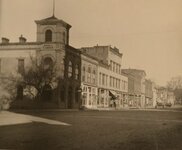
Unknown Date
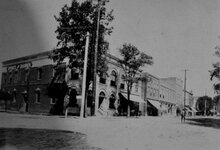
Google Earth Bank Pics


Ooops, I had a typo, sorry. Title SHOULD have read, "$163,000 Bank of Camden Civil War Loot Found In Lancaster County SC".
The Bank Of Camden was in Kershaw County. The treasure was found at Hanging Rock Creek in Lancaster county.
Hanging Rock

Hanging Rock Creek Near Health Springs SC

all their valuables to the Bank Of Camden. This included gold, paper money, jewelry, and even a very heavy solid
gold pitcher that had been gifted to a mister John C. Calhoun by the Ladies of Charleston. The total value of
the cash and valuables was $163,000. (1860's value)
The bank officials then gathered it all up, and headed for Hanging Rock with a plan to bury it all so it would be safe from the
advancing Union army.
While in route to Hanging Rock they ran into a small detachment of Union soldiers. Of course the soldiers confiscated
everything, and for whatever reason, the soldiers decided to bury it all, and for some reason they selected a man from their
outfit named Rhodes, and only him, to do the burying. Maybe they buried it so they could
come back later and keep it all for themselves, or maybe they had already stolen more than they could carry
from other area's? If they already had as much treasure as they could carry, this might also explain why they didn't
worry about Rhodes being the only one who knew where it was? Maybe Rhodes was the "lowest man on the totem pole"
of the group and nobody else wanted to work that hard digging a hole if they all were already carring enough to make
them rich? Nobody really knows why except the soldiers themselves, and they can't talk anymore!
At any rate, going off to bury the plunder, Rhodes crossed Lynch's River near an old mill at the mouth of Hanging Rock
Creek, and buried it all.
The treasure was never recovered before Rhodes died a few years after the war. The fact that it was never recovered
MAY BE a clue that all the soldiers had already gotten rich in the war, and didn't bother trying to find it? Who Knows?
Before he died though, Rhodes provided a description of the place of burial to a Colonel William E Johnston
of Camden.
For twenty years after the war people had dug all over the area that they knew it was buried, but it was nowhere to be found.
Finally, a brother of Rhodes, a friend of his named swaggert, both from the north, along with a negro servant
started their own search. The dug all around the location for three weeks, and finally hit paydirt. Their picks
had uncovered an iron strongbox that held the entire fortune.
Rhodes and Swaggert soon disappeared with all the loot never to be heard from again. Did the servant get a cut?
Who knows, but one thing for sure, all the money and valuables of the citizens in the Lancaster county area were
"made off with".
1880 / Bank looked pretty much the same in Civil War

Unknown Date

Google Earth Bank Pics


Ooops, I had a typo, sorry. Title SHOULD have read, "$163,000 Bank of Camden Civil War Loot Found In Lancaster County SC".
The Bank Of Camden was in Kershaw County. The treasure was found at Hanging Rock Creek in Lancaster county.
Hanging Rock

Hanging Rock Creek Near Health Springs SC

Amazon Forum Fav 👍
Last edited:



